What Happens to the Frost on My Heat Pump?
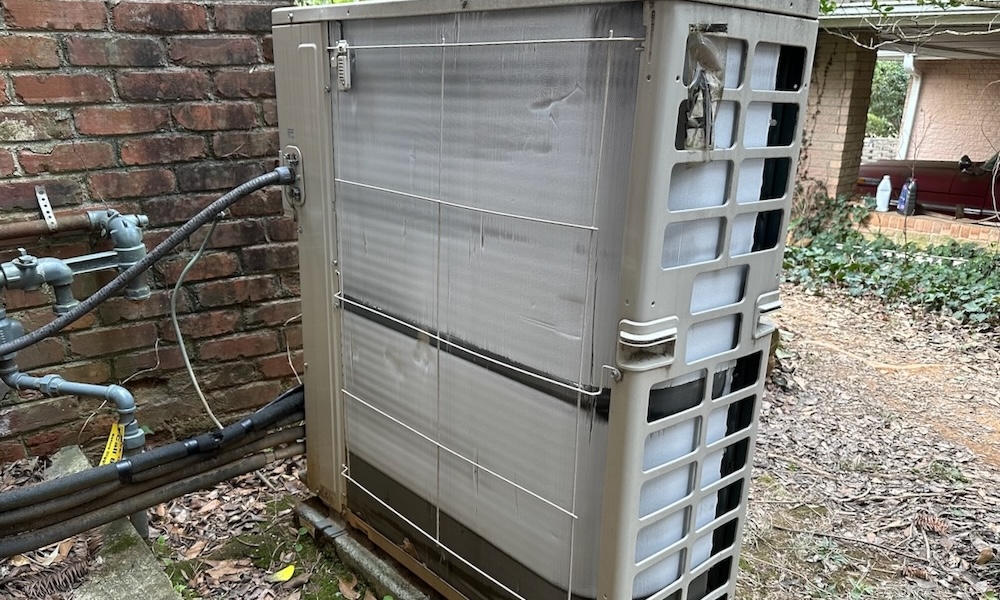
This is the fifth winter since I’ve been heating my house with a Mitsubishi* heat pump. And finally I got to see something I’ve missed every time it happened until last week. Yep. I’m talking about seeing frost on the outdoor unit of my heat pump. So I ran for my phone and shot a video of the heat pump going through its defrost cycle.
The video here explains a bit about how heat pumps work, why frost appears, what happens during the defrost cycle, and some details about the consequences of a frosty heat pump. If you don’t want to watch the video, you can read the transcript below.
Front of outdoor unit
Hi, this is Allison Bailes with Energy Vanguard. And this is what the outdoor unit of my heat pump looks like. This one happens to be a Mitsubishi variable capacity heat pump with an inverter-driven compressor, but I’ve got something special to show in this video and it applies to all heat pumps.
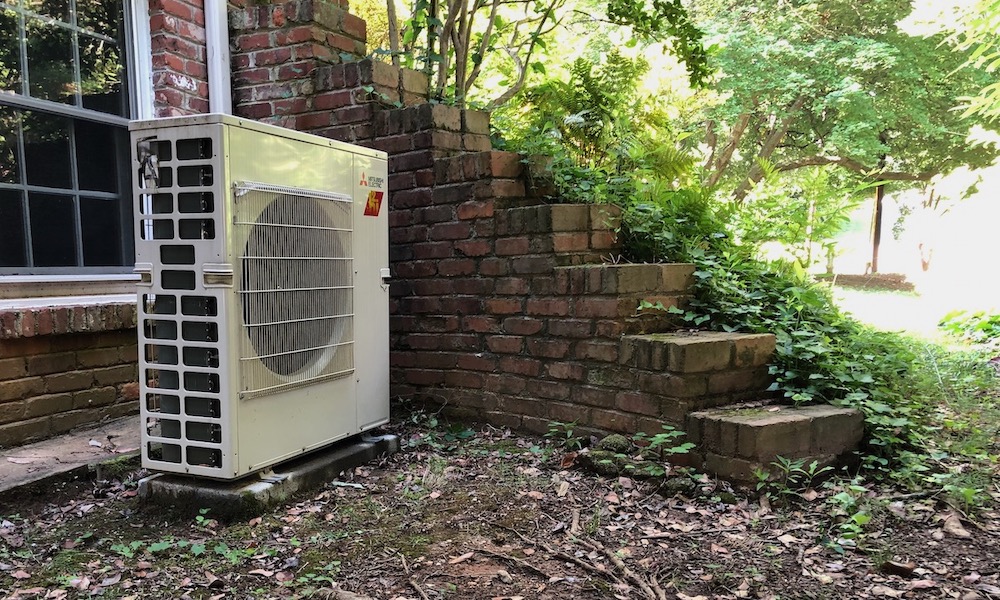
Now, when I say heat pump, you’re probably thinking about HVAC equipment that can do both heating and cooling. But actually, an air conditioner is a heat pump. So is a refrigerator. And a dehumidifier. All of these devices pump heat from one place to another. The only distinction among the various types I just mentioned is whether they pump heat in one direction or two.
The reversing valve
The kind of heat pump that both heats and cools does so because of this component. It’s called a reversing valve, which tells you exactly what it does. It reverses the flow of heat. In summer, it sends heat from indoors to outdoors. In winter, it reverses and sends heat from outdoors to indoors.
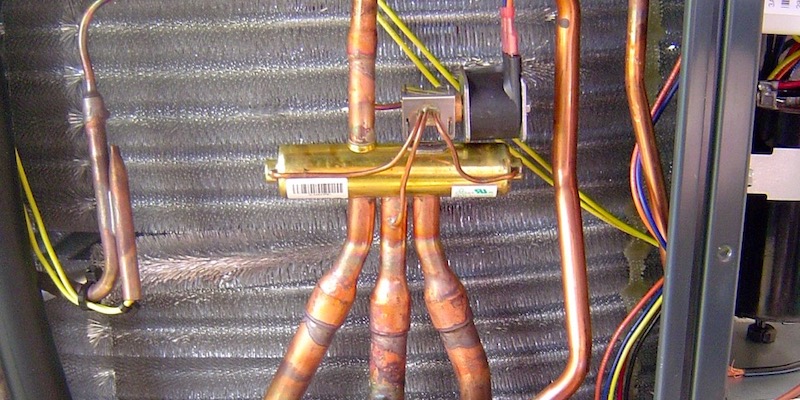
So a more appropriate a name for this type of equipment would be a two-way heat pump. But yeah, I know that’s not gonna get adopted.
Back of the outdoor unit
Anyway, let’s get back to that interesting heating-mode phenomenon I want to show you. Here’s the back side of my heat pump’s outdoor unit. Most of what you see there is the outdoor coil. The refrigerant, which carries the heat from one place to another, goes through copper tubes embedded in vertical aluminum fins.
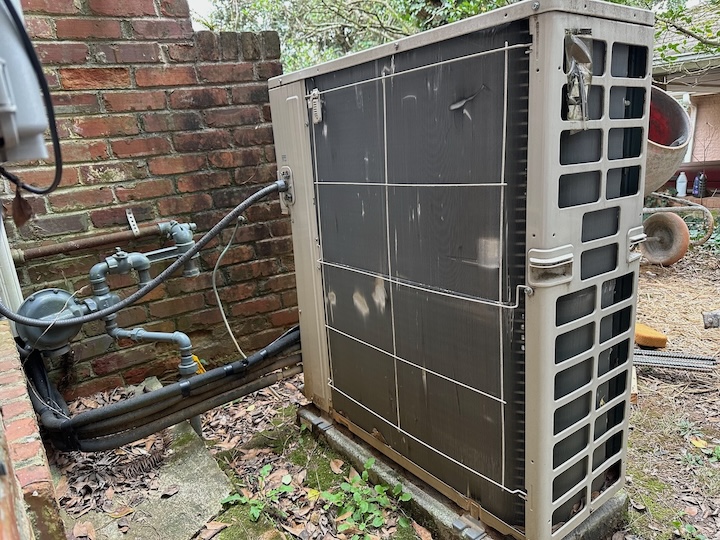
That’s where the heat exchange happens. In summer, the heat goes from the coil to the outdoor air. In winter, the heat goes from the outdoor air into the coil.
Frost on the coil
Now here’s that thing I want to show you. Because the heat pump is pulling heat out of cold air, this is what can happen. Sometimes it gets covered with frost!

Why does frost form? Because heat flows from hot to cold…or in this case, from cold to colder. That’s the magic of a heat pump in heating mode. It makes the outdoor coil colder than the outdoor air.
And because of that, moisture in the outdoor air can condense or freeze on that outdoor coil. Which is what happened here.
So, what do you think the outdoor temperature was when I took this photo?
Nope. No. Not that either. Sorry.
Outdoor temperature
It was actually, as you see here, close to 50 °F, believe it or not. (That’s 10 °C for the rest of the world, by the way.)
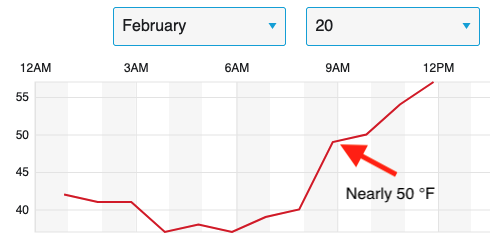
Heat pumps do magic. They can create really cold temperatures, even cold enough to freeze water when the outdoor temperature is well above freezing, as you see here.
Now, the thing about frost on the outdoor coil is that it can reduce the air flow across the coil. And that reduces the coil’s ability to absorb heat, making it less efficient.
So, we don’t want frost there. That’s why heat pump manufacturers have defrost cycles built into their equipment.
Reversing valve, again
And guess how that works. I’m showing the reversing valve here because to melt that frost, the heat pump reverses and goes back into cooling mode.
Video of defrost happening (skip to 3:20 mark of video above)
Now, here’s a video of my heat pump going into its defrost cycle. You can see that it’s begun because some of the frost has already melted.
So defrost works by switching from heating mode to cooling mode. That means it’s bringing heat from indoors and dumping it outdoors. The refrigerant flowing through that outdoor coil now has a lot of heat from indoors. And that’s how it melts the frost.
Also, notice the grass blowing at first but then stopped. When the outdoor unit switched off. The purpose of that is to put as much of that heat from indoors into melting frost, not putting it into the outdoor air. By putting all that heat into the frost, it melts quicker and you can see it dripping off the bottom now.
But there’s a caution in here for those of you in cold climates. Because if that melted frost drips down and refreezes, you can have problems.
Ice beneath outdoor unit in Minnesota
This is a photo sent to me by Randy Williams, a home builder in northern Minnesota. The first thing to note here is that cold air is dry air. The colder the temperature, the less water vapor is available to condense and freeze. But even in a really cold climate, as you see here, there’s still enough water vapor to cause problems.
![Stalagmites of refrozen melted frost beneath an outdoor unit in Minnesota [Courtesy of Randy Williams]](https://www.energyvanguard.com/wp-content/uploads/2024/02/heat-pump-outdoor-unit-minnesota-frozen-condensate.jpg)
Ice on sidewalk in North Carolina
But this can be a problem even in less severe climates. Here’s a photo I took in North Carolina. That’s ice on the sidewalk near the heat pump outdoor units.
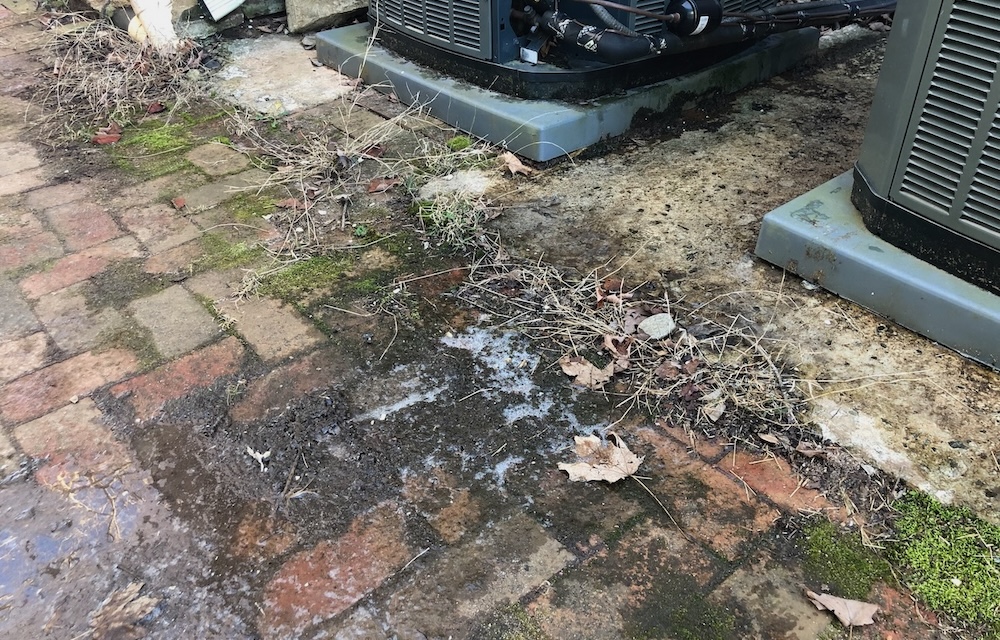
Graph of energy use
Let’s wrap this up with a look at my electricity data for my heat pump. The graph here shows how much electrical power the heat pump is drawing before the defrost cycle started [big peak on left].
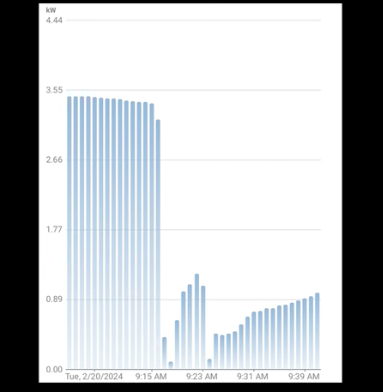
Then, when defrost started, the power use goes down to almost nothing while the reversing valve changes the flow. As the heat pump goes into cooling mode, power use increases. Then it drops to nearly zero again as the reversing valving changes the flow again. And the heating mode results in increasing electrical power use again.
Supply air temperature
Now, what effect does the heat pump turning into an air conditioner on a cold day have on your comfort? A heat pump normally puts out air at a temperature of about 100 °F in heating mode.
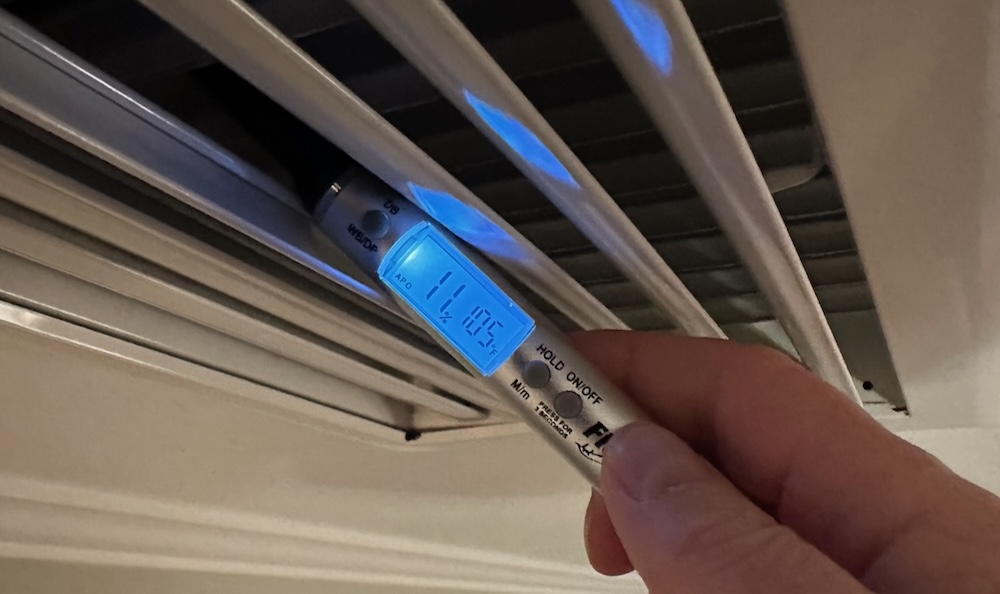
In cooling mode, its job is to make cold air. But no one wants cold air blowing into their house on a cold day. The good news is that manufacturers heard those complaints from the early years of heat pumps.
Electric resistance “strip” heat
One solution is to turn on the auxiliary heat when the defrost cycle starts. That heats up the now cooled air before it blows out of the vents.
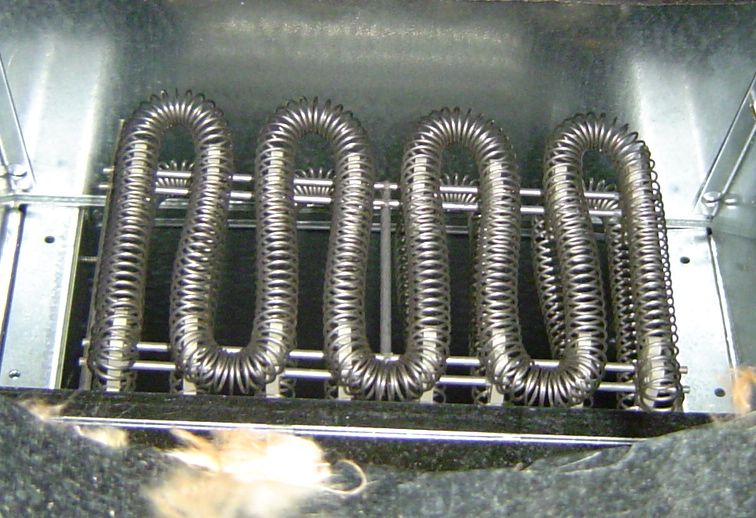
In my case, though, I don’t have auxiliary heat. But with the Mitsubishi heat pump I have the blower stops during the defrost cycle. It doesn’t blow any cold air indoors so we have no comfort problems.
PHOTO OF NORMAL FROST ON COIL
To close, let me just remind you that frost on the outdoor unit of your heat pump is perfectly normal. When it builds up enough, the defrost cycle begins and melts it away.
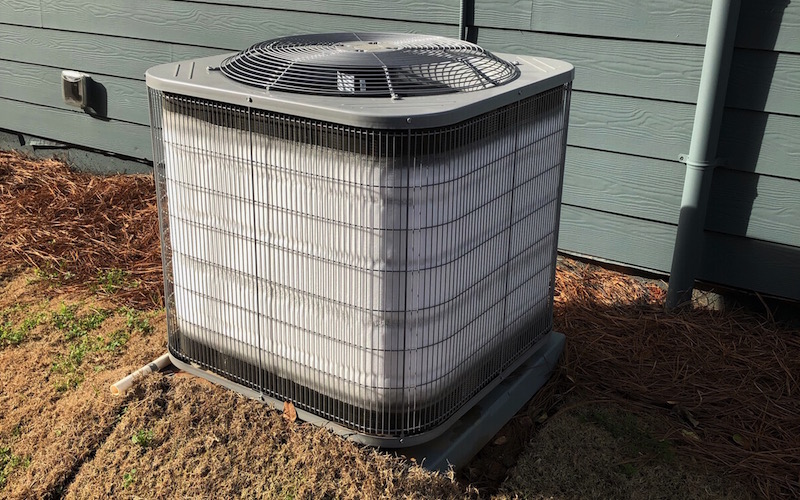
PHOTO OF TOO MUCH FROST ON COIL
But, if you see this much frost on your heat pump, something is wrong. Call your HVAC company.
![Too much frost on a heat pump [Courtesy of Josh Littrell]](https://www.energyvanguard.com/wp-content/uploads/2024/02/heat-pump-hvac-frozen-outdoor-unit-winter-kentucky.jpg)
Allison A. Bailes III, PhD is a speaker, writer, building science consultant, and the founder of Energy Vanguard in Decatur, Georgia. He has a doctorate in physics and is the author of a bestselling book on building science. He also writes the Energy Vanguard Blog. For more updates, you can subscribe to Energy Vanguard’s weekly newsletter and follow him on LinkedIn.
* Disclosure: Mitsubishi is a sponsor of Energy Vanguard.
Related Articles
Why Does My Heat Pump Frost Over?
Why Are Heat Pumps So Dumb About Frost?
How a Heat Pump Gets Heat From Cold Air, Part 2
Comments are welcome and moderated. Your comment will appear below after approval.

You mention photographs but there are no photographs or links to photographs. I agree with old adage that a picture is worth a thousand words, so it seems this weeks blog is about 12,000 words short.
Joking aside, love your articles and in particular the practical realities that often mention.
cheers
Mark
Mark: The photo titles refer to what’s showing in the video at the time I spoke the words below. Maybe I should put them all in there?
Allison
I am in the same situation as Mark. I can’t see any photos or videos. Are others seeing the same thing or is there a problem on our end?
Thanks!
Derek
You should discuss hot gas bypass as an alternate defrost mechanism often employed in “hyper heat” and other low ambient heat pumps.
Good idea, rjp. I’ll add that to the list.
Hot gas is really old tech. It’s been in every ice machine for many decades. Most cheap import minisplits now use it as well. Far better than a typical reversing valve and actually a more simple system.
How does that work?
Allison: What does your indoor unit do when it goes into defrost? Does it blow cold air or does the blower turn off?
Oops, I didn’t read your article close enough when I made this comment. So the blower turns off during defrost. I wonder why ducted heat pumps don’t do that?
Roy: The two air handlers attached to this heat pump are both ducted.
But the blower(s) do shut off during defrost? I wonder why “conventional” ducted heat pumps leave the blower running with auxiliary heat during defrost?
Well, I haven’t verified that, but that’s what Mitsubishi says is supposed to happen. As I mentioned in the video, I’ve caught it in the defrost cycle only that one time, and I was outdoors getting video at the time.
When you have aux heat strips for defrost, you have to keep the inside blower on to keep the strips from burning up. Those heat strips are also used as an emergency heat source if and when the heat pump fails or can not keep up.
If you’re using a Mitsubishi controller advanced settings thermo off, or maybe continuous fan off it’ll stop the blower once set point has been met or in defrost.
First of all there is no magic in the heat cycle. Zero degree air is +459 degrees absolute so it has plenty of heat to extract.
Yes the indoor unit does blow cold in the defrost cycle. It’s usually enough to make my oil burner kick in.
Frost is more likely to form in damp weather than in cold dry conditions.
Good video Allison. Without your Mitsubishi indoor fan running, I’d expect your indoor coil would just get cold fast and not provide much heat for the defrost cycle. Maybe I’m missing something?
In middle Tennessee we recently had a rare week of temps in the single digits and teens. I too for the first time saw frost packed on my home’s heat pump outdoor coil. With the compressor running but not the outdoor fan, I presume it was in defrost mode but it didn’t seem to be melting much. I assume the auxiliary strip heater was cycling to maintain indoor temp while also spinning my electric meter.
I’m curious how operating in such low temps impacts the life of a heat pump compressor. It sounds like it’s working really hard (high refrigerant pressure differential) while not making much heat (persistent coil frost). And considering the regular need for auxiliary heat, probably not saving much energy. A friend suggested, at very low outdoor temps, just switching the thermostat to “emergency” auxiliary heat mode to reduce compressor wear and tear with minimal extra electricity consumption. What do you think?
I enjoy your weekly newsletters. Thanks for what you do.
I live in southern Ontario and while many think it is very cold here, the fact is that we spend much of the winter not too far from 0C (32F). As such, how well heat pumps handle defrost is a significant part of the overall determination of heating efficiency. I think that much more attention should be given to how heat pumps deal with frost. We use a 2 ton York single speed heat pump with 15 kw of strip heaters as our main heat source. I recently added a Senville (Midea) 12k minisplit in the basement. I routinely monitor all electrical inputs and equipment temperatures which are continuous recorded and stored for analysis. You learn a lot about how these things work when you see the data. The York as very predicable demand based defrost that is easy to understand. It is certainly not perfect and in some conditions can get ‘behind’ causing long periods of low efficiency (the 8 minute max defrost time is just not long enough) The minisplit has a mind of its own and what looks like very poor defrost logic. In certain conditions it defrost every 100 minutes frost or not. This seems very unusual for modern equipment. My point is that while defrost performance can be a significant component of heat pump performance, I do see any data on the subject. Why not test all heat pumps at 0C 100%RH?
Doesn’t seem to be any photos?
I know you live in the south but it’s amazing how little you see this. I’m in Idaho and we have to have heaters to melt the frost all winter, and it generates gallons of water a day. Is that typical for splits in cold climates? Mine is a Daikin VRV Life and I’ve been trying to figure out if that’s normal or not.
In extreme cold you need pan heaters to keep the melted frost from the coils from freezing again in the bottom.
There are no photos. Watch the video, the text above is just repeating the video explanation.
Yes but do you know about how much water you should expect to get if things are running normally?
There is no one answer. It depends on how much moisture is in the air.
Chances are your outdoor exchanger is below the dew point so all of the water in the air that pumps through it will condense.
Good news..the state change gives more heat.
Bad news it can freeze which is the main focus of this discussion.
Joe, not all of the water in the air that passes through the coil will condense. The leaving air cannot have a dewpoint that is below the lowest surface temperature of the coil.
Thanks for the thought provoking reply. I can see that the dew point will drop as some of the vapor condenses. Depending on many factors you could get condensation at the inlet but none at the outlet.